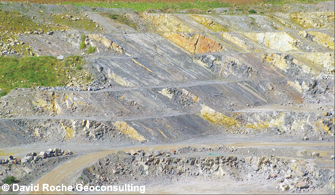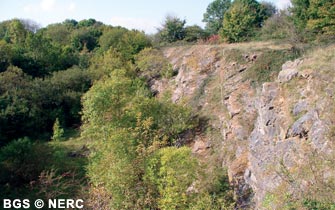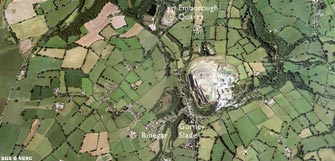
Gurney Slade and Emborough
The region around Gurney Slade and Emborough is geologically quite complex, being located at the eastern end of the Pen Hill Pericline, one of the four major up-folds on Mendip. To the east the Carboniferous Limestone plunges downwards disappearing beneath the Upper Carboniferous Quartzitic Sandstone and the Coal Measures.
South of Gurney Slade, the Carboniferous Limestone forms a down-fold known as the Binegar syncline. To the north, the Emborough area is located on another Syncline, sandwiched between the North Hill Pericline and the Pen Hill Pericline. However, here, the Carboniferous Limestone has also been thrust northwards over the younger Coal Measures along the Emborough Thrust.
The Coal Measures are exposed around Emborough Pond, a lake created by Capability Brown. Although some thin coal seams do occur here, the seams were relatively unproductive. To the east, these folded Carboniferous rocks are partially covered by a blanket of younger rocks, the oldest of which is the Triassic Dolomitic Conglomerate. This is overlain by marine strata; the Penarth and Lias groups which form a distinctive plateau around Ston Easton, and the silicified strata of the Harptree Formation around Emborough. The outcrop of the Harptree Formation is pockmarked with sinkholes formed by dissolution and collapse of the underlying Carboniferous Limestone.
Quarrying

The Gurney Slade area has been a major centre for quarrying since the mid 1800s. Several limestone quarries dot the area, the largest being the active Gurney Slade Quarry which works the Clifton Down Limestone and the Oxwich Head Limestone. The limestone here dips gently to the south-east at around 30°. A small exposure of the horizontally bedded Jurassic Downside Stone can be seen in the south-east corner of the quarry.

The site is a working quarry, so permission to visit should be obtained in advance.
The Clifton Down Limestone was also worked for aggregate in the disused Binegar Quarry, which has been partially infilled with coal waste, and in the dormant Highcroft Quarry in Binergar Bottom. The Upper Carboniferous Quartzitic Sandstone was quarried in Gurney Slade Bottom but the quarry is now overgrown and is on private land.
Neptunian dykes

Sediment infilled fissures within the the Carboniferous Limestone known as Neptunian dykes have been discovered in several of the quarries in the region. The largest were discovered in Emborough Quarry.
These fissures and relict caves are infilled with Triassic and Jurassic sediments and have yielded a wide variety of vertebrate fossil remains, including Keuhneosaurus, an early flying lizard. Similar fissures infilled with Jurassic sediments have been recorded in Gurney Slade Quarry.
- Home
- Overview maps
- Locality
areas
- Cheddar Gorge
- Charterhouse
- Blackdown
- Burrington Combe
- Shipham & Rowberrow
- Crook Peak & Axbridge
- Banwell to Churchill
- Priddy
- Harptree & Smitham Hill
- Draycott & Westbury-sub-Mendip
- Wookey Hole & Ebbor Gorge
- Wells
- Great Elm & Vallis Vale
- Mells & the Wadbury Valley
- The Vobster area
- The Whatley area
- Torr Works & Asham Wood
- Beacon Hill
- Stoke St Michael & Oakhill
- Holwell & Nunney
- Shepton Mallet & Maesbury
- Gurney Slade & Emborough
- The Nettlebridge valley
- Geology
- Minerals and mines
- Quarrying
- Caves and karst
- Biodiversity
- Detailed site information
- Acknowledgements
- External links
- Search
- Site map
